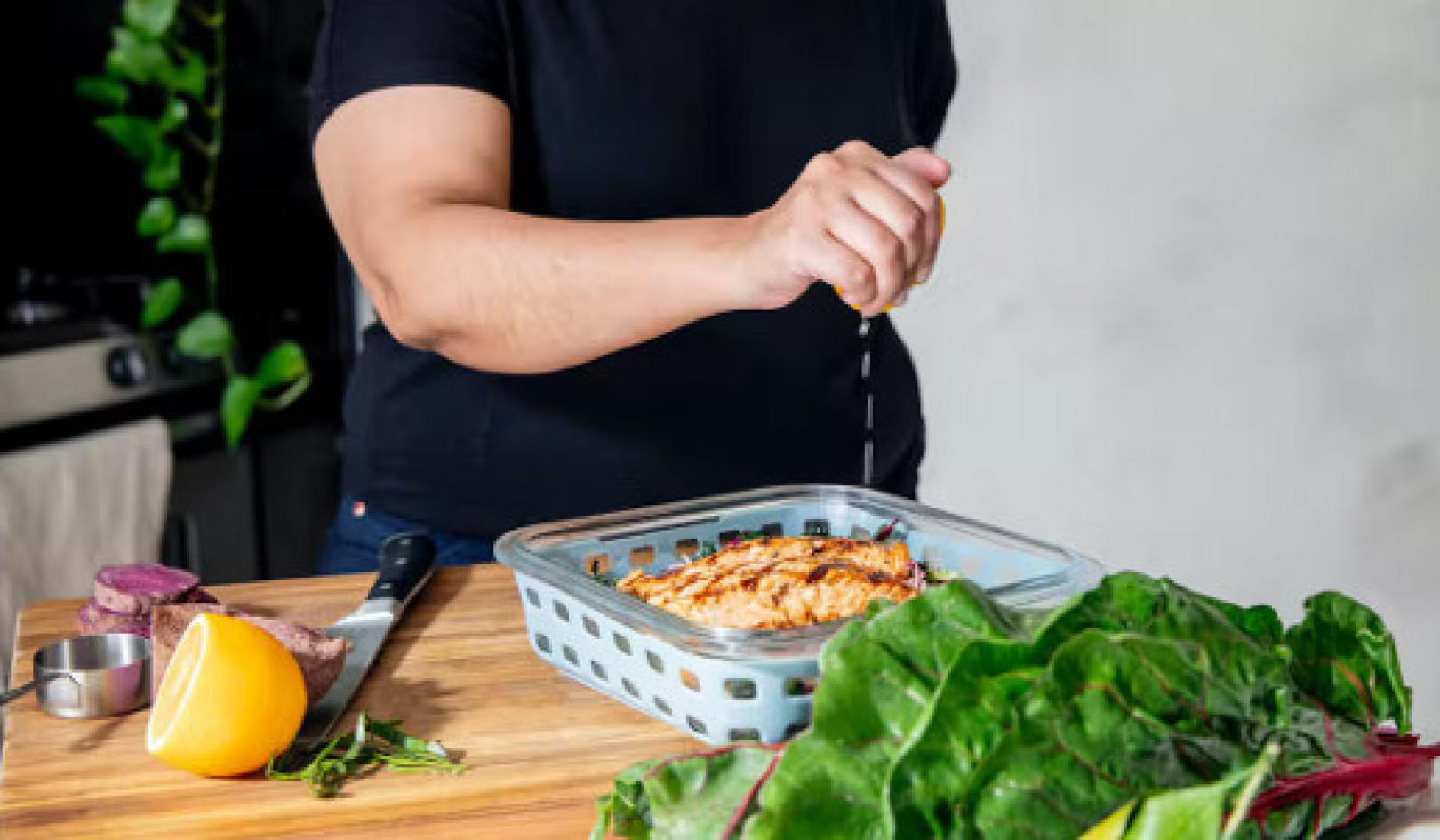Além do conselho usual sobre menos comida e mais exercícios, o estudo sugere que, conscientemente, a substituição de sinais não saudáveis por outros saudáveis em casa poderia ter um impacto real no IMC de uma pessoa, especialmente para as mulheres. (Crédito: Abi Porter / Flickr
Os tipos de alimentos prontos para consumo em uma bancada de cozinha também podem sugerir o peso das pessoas em casa, especialmente as mulheres.
O estudo analisou fotografias de mais de 200 cozinhas em Syracuse, Nova York, para testar como o ambiente alimentar se relaciona com o índice de massa corporal (IMC) dos adultos em casa.
As mulheres no estudo que mantiveram a fruta fresca no exterior tenderam a ser um peso normal em comparação com os seus pares. Mas quando lanches como cereais e refrigerantes eram prontamente acessíveis, essas pessoas eram mais pesadas que seus vizinhos - em média, mais do que 20 libras.
"É a sua dieta básica de ver alimentos - você come o que vê", diz Brian Wansink, professor e diretor do Cornell Food and Brand Lab e principal autor do artigo na revista. Educação em Saúde e Comportamento.
O estudo descobriu que as mulheres que mantinham refrigerantes no balcão pesavam mais 24 a 26 do que aquelas que mantinham a cozinha longe delas. Uma caixa de cereais no balcão estava alinhada com as mulheres que pesavam em média mais de 500 kg a mais do que seus vizinhos que não o faziam.
"Como um amante de cereais, isso me chocou", diz Wansink. "Cereal tem um halo de saúde, mas se você comer um punhado a cada vez que você passar, não vai fazer você magro."
Quando os alimentos não saudáveis são as opções mais visíveis na cozinha, cair em hábitos que levam ao ganho de peso se torna mais fácil. Manter esses alimentos fora da vista, isolando-os em despensas e armários, reduz sua conveniência, tornando menos provável que eles sejam pegos em um momento de fome.
Limpar os contadores dos cereais, refrigerantes e outros itens de salgadinhos e substituí-los por sinais visíveis mais saudáveis, como frutas frescas, pode ajudar, segundo o estudo: Mulheres que tinham uma fruteira visível pesavam cerca de 500 gramas menos que os vizinhos que não o faziam.
O estudo também descobriu que mulheres com peso normal eram mais propensas a ter um armário designado para lanches e menos propensas a comprar alimentos em embalagens de grande porte do que aquelas que são obesas.
As descobertas fornecem novos insights sobre o papel que os fatores ambientais desempenham na obesidade e oferecem remédios para livrar a casa de sinais não saudáveis, ao mesmo tempo em que promovem os saudáveis. Em vez de apenas o habitual aconselhamento dietético prescrevendo menos comida e mais exercício, o estudo sugere que substituir conscientemente as insalubridades por outras saudáveis em casa pode ter um impacto real no IMC de uma pessoa, especialmente para as mulheres.
"Temos um ditado em nosso laboratório:" Se você quer ser magro, fazer o que as pessoas magras fazer ' ", diz Wansink.
Fonte: Matt Hayes para Universidade de Cornell
Livros relacionados:
at
Obrigado pela visita InnerSelf.com, onde existem 20,000+ artigos que alteram vidas promovendo "Novas Atitudes e Novas Possibilidades". Todos os artigos são traduzidos para Mais de 30 idiomas. Subscrever à InnerSelf Magazine, publicada semanalmente, e ao Daily Inspiration de Marie T Russell. Revista Innerself é publicado desde 1985.
Obrigado pela visita InnerSelf.com, onde existem 20,000+ artigos que alteram vidas promovendo "Novas Atitudes e Novas Possibilidades". Todos os artigos são traduzidos para Mais de 30 idiomas. Subscrever à InnerSelf Magazine, publicada semanalmente, e ao Daily Inspiration de Marie T Russell. Revista Innerself é publicado desde 1985.


![bowls of apples & oranges on counter Share This Article facebook twitter Action Beyond the usual advice about less food and more exercise, the study suggests that consciously replacing unhealthy cues with healthy ones in the home could have a real impact on a person's BMI, especially for women. (Credit: Abi Porter/Flickr) How the kitchen counter can predict your weight Cornell University rightOriginal Study Posted by George Lowery-Cornell on October 20, 2015 You are free to share this article under the Attribution 4.0 International license. The types of ready-to-eat foods on a kitchen countertop could also hint at the weight of the people in the home, particularly women. The study looked at photographs of more than 200 kitchens in Syracuse, New York, to test how the food environment relates to the body mass index (BMI) of the adults at home. The women in the study who kept fresh fruit out in the open tended to be a normal weight compared with their peers. But when snacks like cereals and sodas were readily accessible, those people were heavier than their neighbors—by an average of more than 20 pounds. “It’s your basic See-Food Diet—you eat what you see,” says Brian Wansink, professor and director of the Cornell Food and Brand Lab and lead author of the paper in the journal Health Education and Behavior. [Would you take food advice from a heavier blogger?] The study finds that women who kept soft drinks on their counter weighed 24 to 26 pounds more than those who kept their kitchen clear of them. A box of cereal on the counter lined up with women there weighing an average 20 pounds more than their neighbors who didn’t. “As a cereal-lover, that shocked me,” says Wansink. “Cereal has a health-halo, but if you eat a handful every time you walk by, it’s not going to make you skinny.” When unhealthy foods are the most visible options in the kitchen, falling into habits that lead to weight gain becomes easier. Keeping those foods out of sight by sequestering them in pantries and cupboards reduces their convenience, making it less likely that they will be grabbed in a moment of hunger. Clearing the counters of the cereals, sodas, and other snack items and replacing them with healthier visible cues like fresh fruit could help, the study finds: Women who had a fruit bowl visible weighed about 13 pounds less than neighbors who didn’t. [Could a bribe entice you to eat less?] The study also finds that normal-weight women were more likely to have a designated cupboard for snack items and less likely to buy food in large-sized packages than those who are obese. The findings provide new insights into the role environmental factors play with obesity and offer remedies to rid the home of unhealthy cues while promoting the healthy ones. Rather than just the usual dietary advice prescribing less food and more exercise, the study suggests that consciously replacing unhealthy cues with healthy ones in the home could have a real impact on a person’s BMI, especially for women. “We’ve got a saying in our lab, ‘If you want to be skinny, do what skinny people do,'” Wansink says. Source: Matt Hayes for Cornell University](/images/2015/540/apples_and_oranges.jpg)





















